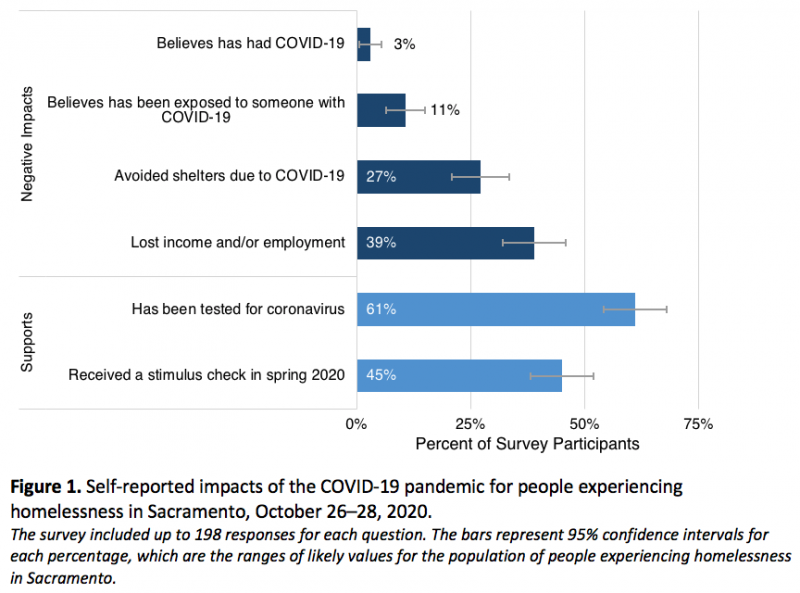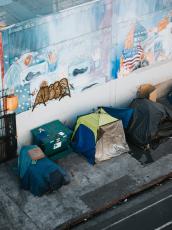Pandemic Compounds Hardships for People Experiencing Homelessness in Sacramento, CA
By Ryan Finnigan, UC Davis
Across the United States, the health and economic impacts of the COVID-19 pandemic are much greater for already disadvantaged people. The health and economic burdens faced by people experiencing homelessness make them especially vulnerable.[1] This vulnerability has been heightened further by the widespread curtailing of crucial services for people experiencing homelessness following COVID-19 outbreaks at temporary shelters. In a recent study, I surveyed close to 200 people experiencing homelessness in Sacramento, California.[2] I found that financial difficulties associated with the pandemic had impacted respondents more significantly than COVID-19 itself. This was compounded by the fact that relatively few of them had received stimulus payments. In light of these findings, policy makers should broaden their definition of the pandemic’s fallout with regard to people experiencing homelessness, and should work to proactively reduce existing barriers to economic relief associated with housing status.
Key Facts
- Health conditions and inadequate access to health care make people experiencing homelessness especially vulnerable to COVID-19, but shelter-in-place orders and physical-distancing recommendations have reduced shelter capacities and other important services.
- Data collected in October 2020 suggested that incidences of COVID-19 have been relatively low in number for people experiencing homelessness in Sacramento, CA.
- Income and job loss were more common than disease exposure. Relatively few people received stimulus payments in the spring of 2020, especially among those with little or no income.
In 2019, the rate of homelessness in Sacramento (36 per 10,000 people) was double the national rate, but similar to the rate in California overall. As of October 2020, Sacramento’s cumulative rates of COVID-19 positive cases (163 per 10,000) and deaths (3 per 10,000) were lower than California’s statewide rates and much lower than the national rates. However, Sacramento’s official unemployment rate (9.8 percent) remained higher than the national rate as of September 2020.
In collaboration with Loaves & Fishes, a homelessness services agency in Sacramento, I collected survey data from 198 people experiencing homelessness. We administered the survey to people receiving Loaves & Fishes’ breakfast and lunch services on October 26–28, 2020. The survey’s demographic composition was generally similar to data from a representative survey of people experiencing homelessness in Sacramento in January 2019.[3] We measured both perceived health-related impacts (exposure to the coronavirus, access to testing, congregate shelter avoidance, and so on) and economic impacts (job loss, income loss, receipt of the stimulus payments in spring 2020).
Economic Impacts More Severe Than Health
The survey results demonstrated low exposure to COVID-19 for people experiencing homelessness in Sacramento. The economic impacts, however, were more severe. Figure 1 shows the percentages of survey participants reporting each of the possible pandemic impacts or receiving the listed supports. Consistent with Sacramento’s relatively low case rates at the time, few survey participants believed they had been infected with (3 percent) or exposed to COVID-19 (11 percent). A few participants even told me that COVID-19 was “not a problem around here.”
A much larger fraction had avoided temporary shelters because they were concerned about COVID-19 (27 percent). Shelter use depends on many factors, though, including low shelter capacities and personal concerns about privacy and autonomy. In 2019, for instance, only 30 percent of people experiencing homelessness in Sacramento were staying in temporary shelters. Some survey participants said they did not use shelters anyway, and thus were not avoiding shelters due to COVID-19. Others continued to use shelters despite serious concerns about COVID-19. Fortunately, most survey participants had access to testing for the novel coronavirus (SARS-CoV-2) that can cause COVID-19. Loaves & Fishes intermittently provides this testing during meal services, making it significantly more accessible than it might otherwise be.

Turning to economic effects, almost two-fifths of survey participants reported a job or income loss between February and October 2020. These losses were less substantial than those experienced by very-low-income housed Californians (defined as having a household income of less than $25,000 in 2019). In a concurrent survey collected by the Census Bureau, 58 percent of very-low-income Californians reported a loss of employment income in their household since March 2020.[4] People experiencing homelessness, on the other hand, already reported low employment and income even prior to the pandemic. Some participants told me that their income had not changed during the pandemic because they “never really had any anyway.” Rather than increasing deprivation for many people experiencing homelessness, the pandemic has arguably perpetuated their severe deprivation instead.
Such deprivation might have been partially alleviated by stimulus checks, beginning with those authorized by the CARES Act. However, fewer than half of the survey participants said they had received a pandemic relief payment in spring 2020, compared to 86 percent of very-low-income housed Californians. Survey participants with no monthly income or incomes below $500 in October 2020 were especially unlikely to say they received a payment.
Broaden Definition of Pandemic Impacts to Enhance Support
Proactive and widespread testing and isolation appear to have been crucial for protecting people experiencing homelessness in Sacramento from SARS-CoV-2.[5] Resources for these ongoing efforts should therefore be maintained. Entities offering economic and housing support to people experiencing homelessness should not treat the pandemic as a new setback, as it might be for many middle-income people. Rather, it should be understood as compounding the enduring marginalization that many of the study participants already faced. California’s Project Homekey will support local governments purchasing vacant hotels, motels, and other housing units for people experiencing homelessness.[6] When considering the pandemic’s impact on such people, Project Homekey and any similar entities should look beyond mere disease exposure or vulnerability and include economic factors in their assessments.
Finally, economic relief efforts should proactively address access-barriers related to housing status. Much like the first, the second round of stimulus payments in January 2021 likely failed to reach many people experiencing homelessness—as will any further payments unless significant adjustments are made. Greater outreach efforts could, for example, assist people experiencing homelessness apply for these payments without having filed taxes. In the first round of stimulus payments, a very small fraction of people received debit cards, but only at the discretion of the Treasury Department. In future payments, the IRS could allow recipients to opt-in to such debit cards in place of direct deposit or physical checks. These and additional efforts to overcome the banking and identification requirements for stimulus payments could partially remedy unequal access related to housing status—a crucial step in easing the hardships faced by people experiencing homelessness, some of which have intensified during the current pandemic.
Ryan Finnigan is Associate Professor of Sociology at the University of California, Davis.
References
[1] Jack Tsai and Michal Wilson. 2020. “COVID-19: a potential public health problem for homeless populations.” The Lancet 5(4): E186–E187. https://doi.org/10.1016/S2468-2667(20)30053-0
[2] Finnigan, R. 2021. Self-reported impacts of the COVID-19 pandemic for people experiencing homelessness in Sacramento, California. Journal of Social Distress and Homelessness. DOI: 10.1080/10530789.2021.1879618
[3] Baiocchi, A., Curry, S., Williams, S., Argüello, T., Price Wolf, J., & Morris, J. 2019. Homelessness in Sacramento County: Results from the 2019 Point-in-Time Count. Institute for Social Research and Sacramento Steps Forward.
[4] United States Census Bureau. 2020. Household Pulse Survey Measuring Household Experiences during the Coronavirus Pandemic. https://www.census.gov/data/experimental-data-products/household-pulse-survey.html
[5] Sacramento County. 2020. Sacramento Homelessness COVID-19 Response Team Weekly Progress Report. https://www.saccounty.net/COVID-19/Documents/25%20Homeless%20Response%20Progress%20Report%20Oct.%2016%202020.pdf
[6] California Department of Housing and Community Development. 2020. Homekey. https://hcd.ca.gov/grants-funding/active-funding/homekey.shtml









